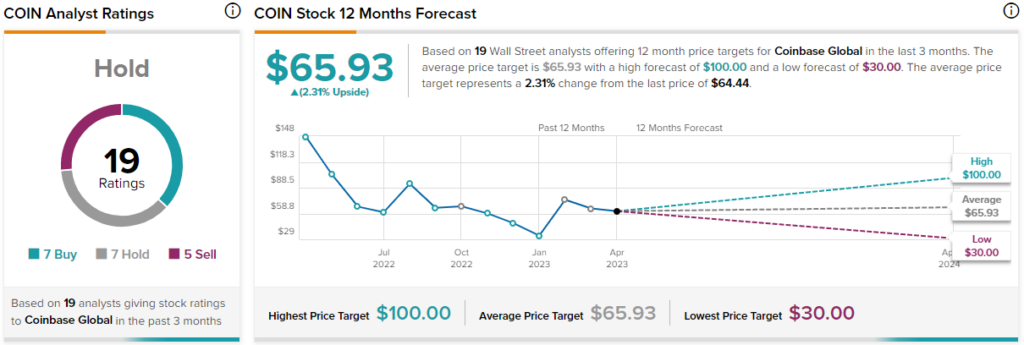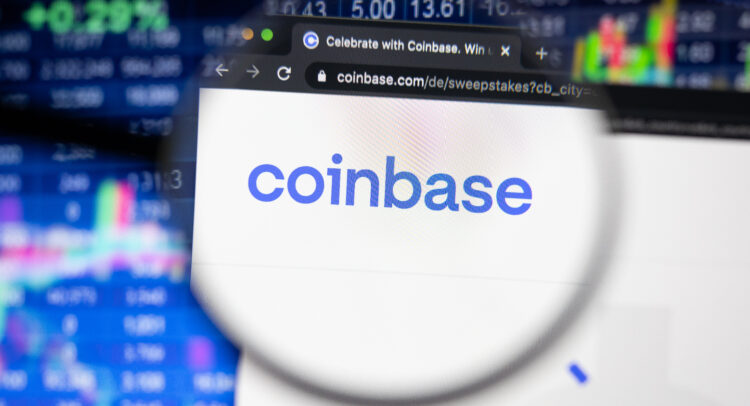Coinbase (NASDAQ:COIN) stock has almost doubled year-to-date. COIN’s rally is partially attributable to the overall recovery in the market, but most importantly, it’s due to cryptocurrencies having posted considerable gains during this period.
Don't Miss our Black Friday Offers:
- Unlock your investing potential with TipRanks Premium - Now At 40% OFF!
- Make smarter investments with weekly expert stock picks from the Smart Investor Newsletter
That said, Coinbase’s investment case remains opaque, with multiple uncertainties attached to its business model. Furthermore, the company has a hard time controlling expenses, which, combined with absurd levels of stock-based compensation, makes it quite hard to create value for shareholders. Simultaneously, shares appear overvalued against Coinbase’s cyclical nature. Accordingly, I am bearish on the stock.

What’s Moving COIN Stock Higher?
There are currently two factors moving shares of Coinbase higher, namely higher crypto prices and rising interest rates. Let’s break them down!
Crypto Rally
The recent rally that cryptocurrencies have experienced is undoubtedly benefiting Coinbase, as higher transaction volumes and higher crypto prices directly translate to higher revenues for the company. This could signal a great improvement from Fiscal 2022, when the company reported 57% lower net revenues as a result of crypto prices and transaction volumes plunging in comparison to the frenzy that persisted in Fiscal 2021.
In addition to higher revenues, rising crypto prices also contribute to the growth of Coinbase’s asset base. Apart from customers’ assets and custodial funds, which were valued at approximately $80 billion at the end of 2022, Coinbase also holds its own cryptocurrencies on the asset side of its balance sheet. Unfortunately, in 2022, the decline in crypto prices caused the value of Coinbase’s own crypto assets to drop by 56% to $424.4 million. However, with the recent surge in crypto prices, the company’s asset base and liquidity are expected to improve considerably this year.
Rising Interest Rates
Likewise, Coinbase investors are growing more confident due to rising interest rates, which allow the company to record higher interest income. This is possible in two ways — firstly, through the company’s participation in the USDC (a digital stablecoin) ecosystem, which allows Coinbase to share any revenue generated from USDC reserves, and secondly, by generating higher interest on customers’ fiat balances. Despite suffering from the decline in crypto prices, Coinbase was able to achieve a massive 79% quarter-over-quarter growth in interest income in Q4 to $182 million. This trend is expected to continue due to further hikes in interest rates.
Why Does Coinbase Stock Have Significant Downside Potential?
Despite the recent enthusiasm surrounding Coinbase, the stock could bear notable downside potential for two reasons. These reasons are the company’s inability to control its expenses, which is going to result in continuous losses and dilution, as well as the stock’s expensive valuation. Let’s take a deeper look.
Continuous Losses Ahead
One of the biggest challenges facing Coinbase is the company’s ongoing struggle to generate profits due to a combination of decreasing revenues and increasing expenses.
Even though rising crypto prices can favorably impact the company’s revenues, crypto prices are still significantly lower than in the first half of 2022 (on average). Simultaneously, while interest income is rising fast, it’s only a fraction of total revenues (just over 10% in Fiscal 2022). Therefore, Coinbase is still going to report a decline in revenues in Q1 2023, which analysts estimate to be by about 44% to $652 million.
Further, we already know Q1 is going to be another money-losing quarter for Coinbase, as management has already guided absurd expenses for the quarter. The firm expects R&D and general and administrative expenses of $625 million to $675 million, sales & marketing expenses of $60 million to $70 million, and restructuring expenses of about $150 million. Therefore, losses should easily exceed $200 million in Q1 alone when considering the aforementioned revenue estimates.
Continuous losses and lack of a roadmap for sustainable profit generation are going to continue to deteriorate shareholder value as the company drains its cash reserves (cash down 47% in Fiscal 2022 to $9.4 billion) and dilutes shareholders (the share count is up 16% since IPO). Excessive levels of stock-based compensation should particularly contribute to the latter.
A Pricy Valuation
The second bearish catalyst Coinbase holds is the stock’s pricy valuation. Coinbase is a highly-cyclical company, and it should be valued as one. While there is the potential for substantial profits if cryptocurrency prices surge, there is also the possibility of sustained losses if prices remain stagnant or continue to decline.
To price in this risk, I wouldn’t value the stock at more than 1x or 2x sales, implying notable downside potential from the current 4.7x sales multiple. This is particularly the case given the company’s overall lack of expense control and management’s inadequate protection of shareholders’ equity.
Is COIN Stock a Buy, According to Analysts?
While not as bearish, Wall Street is not optimistic about COIN. Coinbase stock currently has a Hold consensus rating based on seven Buys, seven Holds, and five Sells assigned in the past three months. At $65.93, the average Coinbase stock forecast implies 2.3% upside potential.

The Takeaway
Coinbase is currently enjoying a couple of strong tailwinds, including rising crypto prices and rising interest rates, which are likely to result in relatively better results this year compared to Fiscal 2022. Nevertheless, with crypto prices remaining below their prior-year period and management’s guidance pointing toward hefty expenses in Q1, Coinbase is set to still record significant losses in its upcoming report and probably throughout 2023.
As the company will need to raise more cash to sustain its spending spree, which will likely include further dilution, shareholders’ equity is set to keep deteriorating. Since the stock’s valuation doesn’t seem to be adequately reflecting these risks, I am bearish on the stock.



















